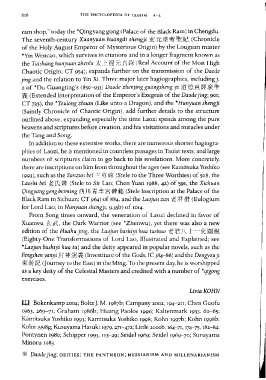Page 658 - The Encyclopedia of Taoism v1_A-L
P. 658
616 THE ENCYCLOPEDIA OF TAOISM A-L
ram shop," today the *Qingyang gong (Palace of the Black Ram) in Chengdu.
The seventh-century Xuanyuan huangdi shengji ~j[;~*~*c. (Chronicle
of the Holy August Emperor of Mysterious Origin) by the Louguan master
*Yin Wencao, which survives in citations and in a longer fragment known as
the Taishang hunyuan zhenlu * L 1fB 5i J'[ %i: (Real Account of the Most High
Chaotic Origin; CT 954), expands further on the transmission of the Daode
jing and the relation to Yin Xi. Three major later hagiographies, includingj.
2 of *Du Guangting's (850-933) Daode zhenjing guangsheng yi jJH!E.\~f&~Ill~
~ (Extended Interpretation of the Emperor's Exegesis of the Daode jing; 901;
CT 725), the *Youlong zhuan (Like unto a Dragon), and the *Hunyuan shengji
(Saintly Chronicle of Chaotic Origin), add further details to the structure
outlined above, expanding especially the time Laozi spends among the pure
heavens and scriptures before creation, and his visitations and miracles under
the Tang and Song.
In addition to these extensive works, there are numerous shorter hagiogra-
phies of Laozi, he is mentioned in countless passages in Taoist texts, and large
numbers of scriptures claim to go back to his revelations. More concretely,
there are inscriptions on him from throughout the ages (see Kamitsuka Yoshiko
1993), such as the Sanzun bei :=: ~~: liilf (Stele to the Three Worthies) of 508, the
Laoshi bei 1;{; ~ 1i!1f. (Stele to Sir Lao; Chen Yuan 1988, 42) of 591, the Xichuan
Qingyang gong beiming @ ) 11 W.$ '§ 1i!1f. jil (Stele Inscription at the Palace of the
Black Ram in Sichuan; CT 964) of 884, and the Laojun zan 'f{;;g-ilU (Eulogium
for Lord Lao; in Hunyuan shengji, 9.35b) of 1014.
From Song times onward, the veneration of Laozi declined in favor of
Xuanwu K lit the Dark Warrior (see *Zhenwu), yet there was also a new
edition of the Huahu jing, the Laojun bashiyi hua tushuo eft U J\.. I' -. it lil ~
(Eighty-One Transformations of Lord Lao, Illustrated and Explained; see
*Laojun bashiyi hua tu) and the deity appeared in popular novels, such as the
Fengshen yanyi :1'.J :f$ ~tif ~ (Investiture of the Gods; le 384-86) and the Dongyou ji
-* j1ft ~t.: (Journey to the East) in the Ming. To the present day, he is worshipped
as a key deity of the Celestial Masters and credited with a number of *qigong
exercises.
LiviaKOHN
m Bokenkamp 2004; BoltzJ. M. 1987b; Campany 2002, 194-2II; Chen Guofu
1963, 269-71; Graham 1986b; Huang Paolos 1996; Kaltenmark 1953, 60-65;
Kamitsuka Yoshiko 1993; Kamitsuka Yoshiko 1998; Kohn 1997b; Kohn 1998b;
Kohn 1998g; Kusuyama Haruki 1979, 271-472; Little 2000b, 164-71, 174-75, 182-84;
Pontynen 1980; Schipper 1993, II3-29; Seidel 1969; Seidel 1969-70; Sunayama
Minoru 1983
* Daodejing; DEITIES: THE PANTHEON; MESSIANISM AND MILLENARIANISM

